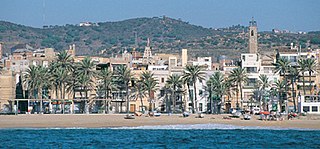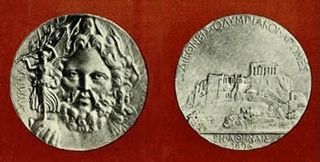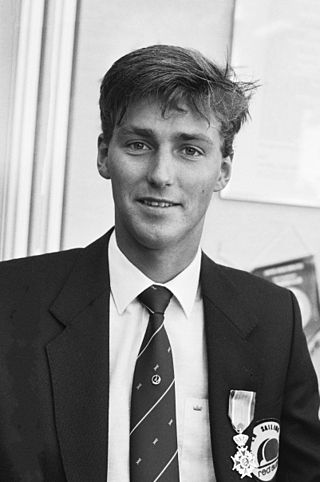Related Research Articles

Badalona is a municipality in Barcelonès county, in Catalonia (Spain). It is located to the north east of Barcelona, on the left bank of the Besòs River and on the Mediterranean Sea, in the Barcelona metropolitan area. By population, it is the third largest city in Catalonia and the twenty-third in Spain. It became a city in 1897.

An Olympic medal is awarded to successful competitors at one of the Olympic Games. There are three classes of medal to be won: gold, silver, and bronze, awarded to first, second, and third place, respectively. The granting of awards is laid out in detail in the Olympic protocols.

A gold medal is a medal awarded for highest achievement in a non-military field. Its name derives from the use of at least a fraction of gold in form of plating or alloying in its manufacture.

The Museu Nacional d'Art de Catalunya, abbreviated as MNAC, is a museum of Catalan visual art located in Barcelona, Catalonia, Spain. Situated on Montjuïc hill at the end of Avinguda de la Reina Maria Cristina, near Pl Espanya, the museum is especially notable for its outstanding collection of romanesque church paintings, and for Catalan art and design from the late 19th and early 20th centuries, including modernisme and noucentisme. The museum is housed in the Palau Nacional, a huge, Italian-style building dating to 1929. The Palau Nacional, which has housed the Museu d'Art de Catalunya since 1934, was declared a national museum in 1990 under the Museums Law passed by the Catalan Government. That same year, a thorough renovation process was launched to refurbish the site, based on plans drawn up by the architects Gae Aulenti and Enric Steegmann, who were later joined in the undertaking by Josep Benedito. The Oval Hall was reopened for the 1992 Summer Olympic Games, and the various collections were installed and opened over the period from 1995 to 2004. The Museu Nacional d'Art de Catalunya was officially inaugurated on 16 December 2004. It is one of the largest museums in Spain.

At the 1992 Summer Olympics in Barcelona, four diving events were contested during a competition that took place at the Piscina Municipal de Montjuïc, from 26 July to 4 August, comprising 100 divers from 31 nations.
Roller hockey was one of three demonstration sports included in the official Olympic programme of the 1992 Summer Olympics, held in Barcelona. This sport's widespread popularity and the existence of top-level competitive teams in Catalonia prompted the Organizing Committee to suggest its inclusion in the Olympic programme.
The semi-finals of the 1992 Summer Olympics roller hockey competition were staged between 1 and 5 August at the Pavelló d'Esports de Reus, in Reus. At this phase, a new group included the six teams which advanced from the preliminary round groups – Argentina, Brazil, Italy, Netherlands, Portugal and Spain. Every team played against each other one time, for a total of 5 matches, one match per day. In the end, the best two teams qualified for the final match to award the gold medal and the third and fourth teams competed for the bronze medal.
One of the most profitable aspects of the Royal Canadian Mint (RCM) is its numismatic product line. The first numismatic coin from the RCM was arguably the 1935 dollar commemorating the Silver Jubilee of His Majesty King George V. Though intended for circulation, it was the first Canadian coin commemorating an event. The decision to issue this coin was made in October 1934 by then-Prime Minister R.B. Bennett. There were economic and patriotic motivations for the release of a silver dollar, including a hope to boost the silver mining industry. In future years, the silver dollar would have a more emotional meaning for many Canadians because it was also the first coin to have the Voyageur motif on its reverse.
By 1954, a new trend was beginning to emerge for the Royal Canadian Numismatic Association as annual meetings evolved into annual conventions. Working with the Toronto Coin Club as host, the first such convention was held in Toronto in 1954. The conventions offered an agenda of educational forums, bourse activity, competitive exhibits with awards to the winners, and a closing banquet, with the highlight being a special guest speaker.. It was also in 1954 that the association issued its first ever medal to commemorate the event. The tradition of an annual convention and a convention medal continues to this very day.

Stephan van den Berg is a retired windsurfer from the Netherlands. He was world champion in 1983 and in the 1984 Summer Olympics, Long beach, California won the first Olympic Gold medal in the Windglider for the Netherlands. After that he turned professional and therefore missed the 1988 Olympics. He returned to amateurs to compete at the 1992 Olympics, Barcelona where he finished in seventh place in the Men's Lechner A-390.
Starting in 1997, the Royal Canadian Mint started to sell hockey medallions to the public. To commemorate the induction of Mario Lemieux in the Hockey Hall of Fame, a set was issued honouring all three inductees. One set was issued in Sterling Silver while another was issued in Nickel. The success of the release led to future issues.
Roy Heiner is a sailor from the Netherlands, who represented his country at the 1988 Summer Olympics in Pusan. Heiner took 7th place in the Finn. In 1992 Summer Olympics, Barcelona Heiner helmed the Dutch Soling. With crew members Peter Burggraaff and Han Bergsma Heiner took 18th place. Heiner switched back to the Finn for the 1996 Summer Olympics, Savannah and took the bronze medal. His last Olympic appearance was in the 2000 Sydney Olympics. With crew members Peter van Niekerk and Dirk de Ridder Heiner took 4th place in the Soling.
Dorien Berendina Lubertha de Vries is a sailor from the Netherlands, who represented her country at the 1992 Summer Olympics in Barcelona. De Vries took the Bronze medal on the Women's Lechner A-390. De Vries returned to the 1996 Olympics in Savannah, Georgia where she took 10th place on the Women's Mistral One Design.

Jordi Ramisa is a Catalan architect, a sculptor and a drawing professor.

The Museum and Study Center of Sport Doctor Melcior Colet is a facility dedicated to the promotion and exhibition of the most prominent in the development of the history of the sport in Catalonia in recent centuries. It is based in an Art Nouveau house built in 1911 by Josep Puig i Cadafalch the Casa Pere Company, which is located in Buenos Aires street, 56, Barcelona.
The Soling Competition at the 1992 Summer Olympics was held from 27 July to 4 August 1992 in Barcelona, Spain. The competition was for the first time in a combined format. First the competitors had to sail a series of six fleet races. Points were awarded for placement in each race. The best five out of six race scores counted for placement in the match race series. After the fleetraces the top 6 placed boats sailed a round-robin series of match races. After the round-robin the best four proceeded to the semi-finals. Here the boat placed 1st met the boat placed 4th and the boat placed 2nd met the boat placed 3rd in a best out of three series of match races. Finally the winners of the semi-finals met in the final best out of three match races. The losers of the semi-finals also met in a best out of three series of matches for the bronze medal.
Jan Kouwenhoven is a sailor from the Netherlands, who represented his country at the 1992 Summer Olympics in Barcelona. Kouwenhoven as crew in the Dutch Men's 470 with his twin brother Ben Kouwenhoven as helmsman took the 16th place. In 1996 Kouwenhoven returned to the Olympics in Savannah, Georgia. Again with his brother, Kouwenhoven took 24th place in the Men's 470.
The 5,000 yen coin is a denomination of the Japanese yen used only for commemoratives struck by the Japan Mint. These are made only for collectors who purchase them directly from the mint at a premium. 5000 yen commemorative coins have historically been struck in a silver alloy since 1990. This practice changed in 2021 when gold was used for the first time for a coin celebrating 150 years of Japan's modern currency system. Measurements for the coins in terms of width and weight have remained the same except for the gold issue when these were lowered. Earlier coins were also once struck in the millions before the alloy change took place.
The 1988 Olympic commemorative coins are a series of commemorative coins which were issued by the United States Mint in 1988.
The 1992 Olympic commemorative coins are a series of commemorative coins which were issued by the United States Mint in 1992.